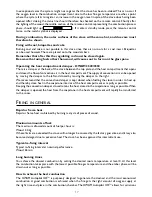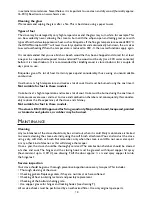
17
In exceptional cases the system might not register that the stove has been re-stoked. This can occur if
the oxygen level in the combustion compartment, due to the low flue gas temperature, reaches a point
where the system fails to register an increase in the oxygen level in spite of the stove door having been
opened. After stoking, the status line should therefore be checked on the remote control. Shortly after
the lighting of the wood, the middle section of the remote control, representing the combustion process
phase, should light up (
). If it enters standby mode, press the remote control
twice, so the match symbol is displayed.
During combustion, the outer surfaces of the stove will become hot, and due care must
therefore be shown.
Firing with coal, briquettes and coke
Burning coal and coke is not possible in this stove since there is no room for a coal insert. Briquettes
can be used however. These are placed onto the wood embers.
Remember that after this the regulating rod must be closed again.
Be aware that using fuels other than wood, will cause soot to form on the glass pane.
Operating the heat compartment damper - HWAM 3520/3530
There is a damper at the back of the stove between the top plate and the heat compartment that opens
and closes the flow of convection air in the heat compartment. The supply of convection air can be opened
by moving the damper to the left and closed by moving the damper to the right.
We recommend that the convection damper is kept closed when fuelling the stove in order to heat up
and thereby store heat in the soapstone interior of the heat compartment as rapidly as possible.
Keeping the convection damper closed retains the heat stored in the soapstone as long as possible. When
the damper is opened, the heat from the soapstone in the heat compartment will rapidly be transferred
to the room.
F
iRing
in
gEnERAl
Rapid or fierce heat
Rapid or fierce heat is obtained by burning many small pieces of wood.
Maximum amounts of fuel:
The maximum allowed amount of fuel per hour is:
Wood: 2.4 kg
If these limits are exceeded, the stove will no longer be covered by the factory guarantee, and it may also
become damaged due to excessive heat. The stove has been approved for intermittent use.
Typical re-firing interval
Typical re-firing interval at nominal performance
Wood: 65 min
Long burning times
You achieve the slowest combustion by setting the desired room temperature at level 0. At this level
the combustion takes place with the lowest possible flue gas temperature and the ember phase will be
drawn out as long as possible.
How to achieve the best combustion
The HWAM Autopilot IHS
TM
is purposely designed to generate the cleanest and the most economical
combustion. A good combustion is achieved when the fire gets the right amount of oxygen supply at
the right time and place in the combustion chamber. The HWAM Autopilot IHS
TM
allows for variations
Summary of Contents for Autopilot IHS 3420
Page 1: ...05 12 2014 97 9662 www hwam com 578 006 Users manual Instruzoni per l uso IT GB 3520 3530 3420...
Page 2: ...2...
Page 4: ...4 B C A 9 11 10 17 1 6 5 8 2a 3 15 4 16 4 3 14 12 13 2b 11 12 14 14 15 3 1 1 4 45 4 3 2 1...
Page 5: ...5 6 2 1 3 4 5 E F...
Page 21: ...21...
Page 37: ...37...
Page 38: ...38...
Page 39: ......
Page 40: ...www hwam com...
















































